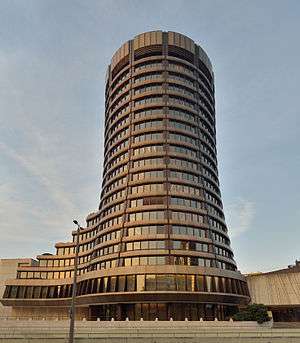Basel Committee on Banking Supervision

The Basel Committee on Banking Supervision (BCBS)[1] is a committee of banking supervisory authorities that was established by the central bank governors of the Group of Ten countries in 1974.[2] It provides a forum for regular cooperation on banking supervisory matters. Its objective is to enhance understanding of key supervisory issues and improve the quality of banking supervision worldwide. The Committee frames guidelines and standards in different areas – some of the better known among them are the international standards on capital adequacy, the Core Principles for Effective Banking Supervision and the Concordat on cross-border banking supervision.[3] The Committee's Secretariat is located at the Bank for International Settlements (BIS) in Basel, Switzerland. The Bank for International Settlements (BIS) hosts and supports a number of international institutions engaged in standard setting and financial stability, one of which is BCBS. Yet like the other committees, BCBS has its own governance arrangements, reporting lines and agendas, guided by the central bank governors of the Group of Ten countries. [4]
Goals
The purpose of BCBS is to encourage convergence toward common approaches and standards. The Committee is not a classical multilateral organization, in part because it has no founding treaty. BCBS does not issue binding regulation; rather, it functions as an informal forum in which policy solutions and standards are developed.[5]
The Basel Committee formulates broad supervisory standards and guidelines and recommends statements of best practice in banking supervision (see bank regulation or "Basel III Accord", for example) in the expectation that member authorities and other nations' authorities will take steps to implement them through their own national systems.
Organization
The Basel committee along with its sister organizations, the International Organization of Securities Commissions and International Association of Insurance Supervisors together make up the Joint Forum of international financial regulators.
The present[6] Chairman of the Committee is Stefan Ingves, Governor of the central bank of Sweden (Sveriges Riksbank).[7] William Coen is the current Secretary General of the Basel Committee.[8]
Member countries
Currently, committee members come from Argentina, Australia, Belgium, Brazil, Canada, China, France, Germany, Hong Kong, India, Indonesia, Italy, Japan, Korea, Luxembourg, Mexico, the Netherlands, Russia, Saudi Arabia, Singapore, South Africa, Spain, Sweden, Switzerland, Turkey, the United Kingdom and the United States. The Committee's Secretariat is located at the Bank for International Settlements (BIS) in Basel, Switzerland. However, the BIS and the Basel Committee remain two distinct entities.
Until 2009, members included only developed countries: Belgium, Canada, France, Germany, Italy, Japan, Netherlands, Spain, Sweden, Switzerland, United Kingdom and the United States. [9]
Groups
The Committee is sub-divided into groups, each of which have specific task forces to work on specific issues:
- The Standards Implementation Group (SIG)
- Operational Risk Subgroup - addresses issues related to Advanced Measurement Approach for Operational Risk
- Task Force on Colleges - develops guidance on the Basel Committee's work on supervisory colleges
- Task Force on Remuneration - promotes the adoption of sound remuneration practices
- Standards Monitoring Procedures Task Force - develops procedures to achieve greater effectiveness and consistency in standards monitoring and implementation
- The Policy Development Group (PDG)
- Risk Management and Modelling Group - point of contact with the industry on the latest advances in risk measurement and management
- Research Task Force - facilitates economists from member institutions to discuss research on financial stability in consultation with the academic sector
- Trading Book Group - reviews how risks in the trading book should be captured by regulatory capital
- Working Group on Liquidity - works on global standards for liquidity risk management and regulation
- Definition of Capital Subgroup - reviews eligible capital instruments
- Capital Monitoring Group - co-ordinates the expertise of national supervisor in monitoring capital requirements
- Cross-border Bank Resolution Group - compares the national policies, legal frameworks and the allocation of responsibilities for the resolution of banks with significant cross-border operations
- The Accounting Task Force (ATF) - ensures that accounting and auditing standards help promote sound risk management thereby maintaining the safety and soundness of the banking system
- Audit subgroup - explores key audit issues and co-ordinates with other bodies to promote standards
- The Basel Consultative Group (BCG) - facilitates engagement between banking supervisors including dialogue with non-member countries
Standards
The Committee agrees on standards for bank capital, liquidity and funding. Those standards are non-binding high-level principles. Members are expected but not obliged to undertake effort to implement them e.g. through domestic regulation.
See also
References
- ↑ Basel Committee on Banking Supervision
- ↑ See the "History of the Basel Committee and its Membership" in http://www.bis.org/bcbs/history.pdf
- ↑ "About the Basel Committee". www.bis.org. 28 June 2011.
- ↑ "About committees and associations". www.bis.org. 4 August 2005.
- ↑ Kerwer, Dieter. "Rules that many use: standards and global regulation," Governance (US). Vol. 18, Issue 4, p. 616. October 2005
- ↑ "Chairmen of the Basel Committee". www.bis.org. 2013-04-22. Retrieved 2016-03-11.
- ↑ Fact sheet - Basel Committee on Banking Supervision Bank for International Settlements website
- ↑ "Press release: William Coen appointed as the next Secretary General of the Basel Committee". www.bis.org. 2014-04-23. Retrieved 2016-03-11.
- ↑ Marrison, Chris (2002). The Fundamentals of Risk Measurement. New York, New York: McGraw Hill. pp. 340–342. ISBN 0-07-138627-0.
External links
- Basel Committee on Banking Supervision at the Bank for International Settlements website
- http://bis2information.org: Practical articles, on BIS2 and risk modelling, submitted by professionals to help create an industry standard.
- BCBS: A History of the Early Years, 1974-1997 by Charles Goodhart (2011), reviewed by The Oxonian Review